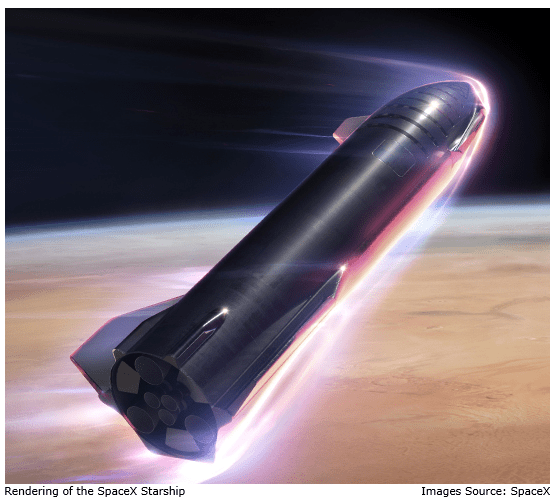https://ift.tt/32QU8ix
Story Highlights:
- SpaceX is building its first “spaceport” in Los Angeles, California.
- The tiny technology that will play a crucial role in our race to space.
- The best way to buy into the space industry today, before it tops $1 trillion by 2040.
One industry is using “out of this world” technology that’s about to make big waves for us in America 2.0.
I’m talking about space.
I don’t know about final, but our next frontier will be space.
The global space industry could generate revenue of more than $1 trillion by 2040. That’s huge!
And who else would be leading this charge but Tesla’s Elon Musk.
Last Wednesday, I tweeted this out:
“Get ready! Elon Musk’s SpaceX Starship manufacturing plant just approved to be built in Los Angeles. L.A. to become a ‘Spaceport.’”
Get Ready! Elon Musk’s SpaceX Starship manufacturing plant just approved to be built in Los Angeles. L.A. to become a “Spaceport.” https://t.co/BEGKoWdSvQ
— Amber Lancaster (@ALancasterGuru) February 26, 2020
I can tell you, this news got people talking.
One reader replied: “Amazing indeed.”
Another reader enthusiastically commented that my dog, Alex, “could be the first dog to set foot on the moon.” This one made me chuckle.
For those who may be unfamiliar with the Starship spacecraft, SpaceX describes it like so:
Starship serves as a large, long-duration spacecraft capable of carrying passengers or cargo to Earth orbit … the Moon, Mars and beyond. Starship will be the world’s most powerful launch vehicle ever developed, with the ability to carry in excess of 100 metric tonnes to Earth orbit. Drawing on an extensive history of launch vehicle and engine development programs, SpaceX has been rapidly iterating on the design of Starship with orbital-flight targeted for 2020.

After a unanimous vote, SpaceX is going to build its Starship manufacturing plant in the Port of Los Angeles.
This is a big deal. Soon, passenger space travel is going to be a reality.
In addition to SpaceX, there’s another technology in the space industry pushing our America 2.0 agenda.
1 Crucial Tech Behind the Space Race
There’s a rapidly growing market for tiny, new-world satellites.
In our Profits Unlimited weekly webcast, Paul and I answered a question about this from a subscriber named Richard.
He wanted to know what we thought about the “new types of satellites positioned just 750 miles above the earth compared to the older versions 23,000 miles up. This design will supposedly provide worldwide coverage at a very low cost.”
I’m so glad you asked, Richard!
The advent of new-world, cutting-edge satellites — known as nanosatellites — is here.
This rapidly growing next-generation nanosatellite industry is completely disrupting the old-world market of yesteryear.
I recently wrote more about this growing industry. (You can read the full article here.)
Here are things to keep in mind when it comes to the nanosatellite market:
- This rapidly growing market for tiny, new-world nanosatellites is disrupting old-world satellites and is still expected to grow by 22% annually over the next five years.
- The global space industry could generate revenue of more than $1 trillion by 2040, up from $350 billion today.
- Since Tesla’s Elon Musk set his sights on space, he’s created an investment opportunity for you to tap into this growing mega trend.

Nanosatellites are tiny airships weighing as little as two pounds. Plus, they are cheaper to launch into space because of SpaceX’s technology and other similar options.
They have the capabilities of larger satellites, but in a miniaturized package. Instead of costing $100 million to build and launch, their costs are in the thousands.
Today, there are three types of satellite system orbits. They all work to power your different technological needs, from your GPS to weather updates to phone calls. They are:
- Geosynchronous orbits (GEO) — GEO satellites orbit the Earth at high altitudes, at more than 22,223 miles above the Earth’s surface.
- Medium Earth orbits (MEO) — As the name suggests, MEO satellites orbit just below GEO satellites, reaching average altitudes of 11,733 miles above the Earth’s surface.
- Low Earth orbits (LEO) — LEO satellites’ average altitude is 450 miles above the Earth. Since they are closer to the Earth’s surface, they have the fastest transmission times and are cheaper to launch into orbit where rocket fuel is concerned.
Since the rise of SpaceX and technological innovation, satellites are getting smaller. More nanosatellites are in development and scheduled for launch.
Invest in the Space Frontier
To play innovation in the space frontier, I suggest buying the ARK Autonomous Technology & Robotics ETF (BATS: ARKQ).
This exchange-traded fund (ETF) will invest in equity securities of companies relevant to the theme of industrial innovation.
Companies in this ETF are focused on — and are expected to substantially benefit from — the development of new products or services, technological improvements and advancements in scientific research related to multiple disciplines, including space exploration.
With the recent Starship news and the innovative developments in nanosatellite technology, space is the investment to be in for the long run in America 2.0.
These recent leaps and bounds in the space industry are not to be missed.
Until next time,

Amber Lancaster
Director of Investment Research, Banyan Hill Publishing
Комментариев нет:
Отправить комментарий